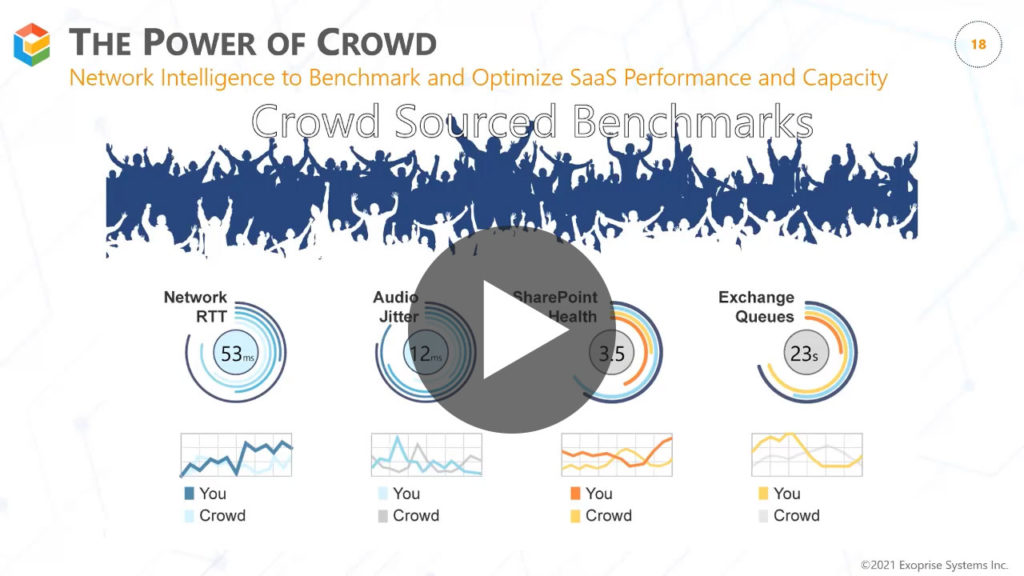With every webpage loaded, email sent, or video streamed, network traffic takes a complex journey…
Maintaining call quality with Microsoft Teams is a process, not a one time event. Network engineers and Microsoft Teams application owners need to be vigilant in preserving optimal call quality to ensure audio, video, and screen-sharing always remain satisfactory for end-users. And vigilance is just as important before the pandemic as it is during the pandemic no matter where your users are working from. In some ways its more important today when working from home. Exoprise is here to help with unique solutions for proactively monitoring Microsoft Teams. In this article we cover how the Microsoft Teams Call Quality Dashboard (CQD) combined with the audio/video synthetic transaction monitoring improves this maintenance process.
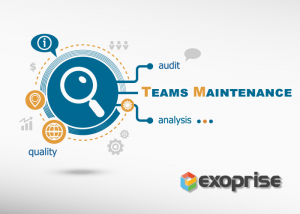
Teams Audio, Video, and Messaging Synthetics
Once Microsoft Teams has been adopted for business collaboration, service owners will need a plan for ongoing monitoring and maintenance. At a minimum they will need to stay on top of the call quality with frequent visits to the Call Quality Dashboard. Proactive synthetics should be a part of everyone’s Microsoft Teams monitoring strategy. Key, high-level benefits of proactive synthetic testing of Microsoft Teams include:
- Network scenario what-if, testing and experimentation with no impact to the end-users
- Faster network change management and root-cause capabilities
- Immediate detection of outages before they impact end-users
- Crowd-sourced benchmarks for networking jitter, network congestion, dropped packets and more
- Network modeling of different topologies like SDWAN, VPN, Proxy, and WiFi access points
By utilizing CloudReady alongside the Teams CQD, professional network engineers can generate monotonic, synthetic Teams Audio and Video sessions which assist with diagnostics and Teams call quality maintenance. This improves productivity through multiple ITOps teams across multiple functions. Ultimately it improves business networking and productivity.
Exoprise and Microsoft Teams Call Quality Dashboard
Data for the CQD is collected in Near-Real-Time (NRT) and typically takes about 30-60 minutes before it is loaded. Exoprise Teams synthetics send data to its servers in real-time and also contribute data to the CQD. This provides the best of both worlds; proactive monitoring from Exoprise with long term call classification from Microsoft in the Teams CQD to analyze call quality and reliability.
Synthetic Calls Captured in Microsoft Call Quality Dashboard
To the right is a recent snapshot of the Exoprise Call Quality Dashboard. For a fairly small company (agile!), it is a large number of audio/video calls, tests and executions generating continuous call quality samples for testing and change management purposes.
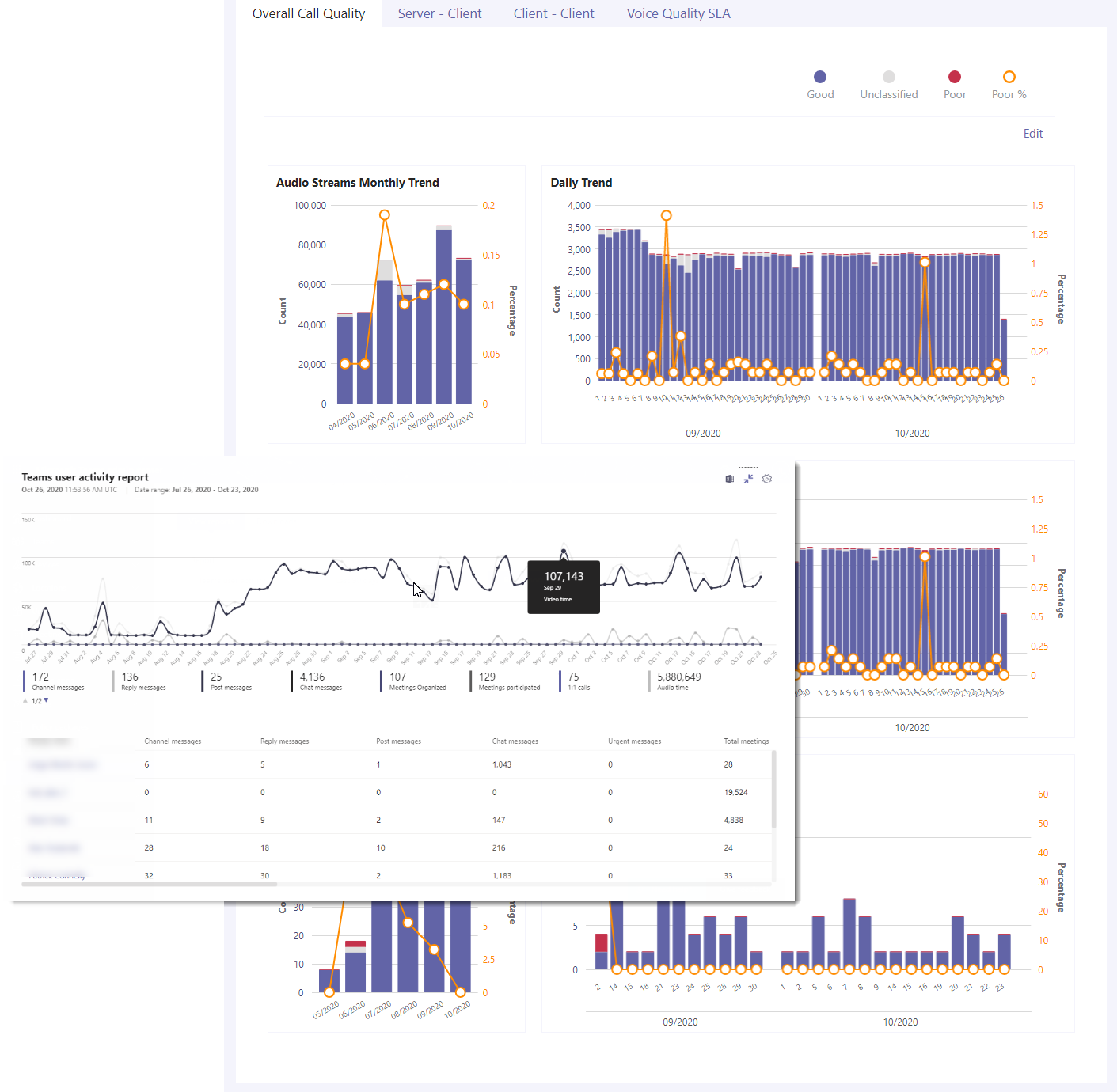 +
+Quick To Deploy – Any Location: WFH, WiFi, VPN
Exoprise sensors deploy quickly for testing any network scenario including SD-WAN, MPLS, VPN, cloud proxies, WiFi access points. Even Working from Home (WFH). A single sensor for monitoring Microsoft Teams Audio/Video streams can operate alongside any workload, physical or virtual computer. Monitoring can easily be deployed alongside a users home or corporate machine if the home ISP or VPN connection is suspected.
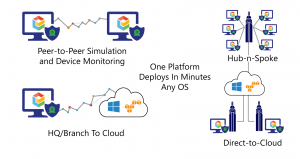
Once deployed, an Exoprise Teams sensor will begin immediately collecting network and Teams audio voice quality telemetry, uploading it to CloudReady servers in addition to the Call Quality Dashboard reports for data collection. That’s because Exoprise uniquely utilizes the real WebRTC call stack to drive an Exoprise Teams AV Bot for synthetic audio/video session creation and analysis. The quality of experience (QoE) data that clients send to Microsoft 365 or Office 365 is the same from the synthetic Teams sensors.
Importantly, this means no waiting weeks for enough real user samples to be generated for conference or peer-to-peer calls. Immediately benchmark and compare network telemetry. Immediately capture CQD data 24×7 for each sensor location and each network configuration.
Easy Quality of Service (QoS) What-If Scenarios for Microsoft Teams CQD
Quality of Service (QoS) for Microsoft Teams is critical for optimizing audio and video streams. When configured properly end-to-end in a network, QoS policy and settings enable network traffic from Microsoft Teams to be prioritized versus other traffic on the network. Voice, video and screen share streams get dedicated ports of network bandwidth.
But Quality of Service configuration can be tricky to establish and ensure is operating well. Often new network components are introduced, settings lost or changed, and possibly new routing introduced. Ensuring QoS settings are properly established and maintained is another continuous process that is made easier by the Call Quality Dashboard and Exoprise together.
Exoprise sensors run 24×7 and synthetically generate real Microsoft Teams audio/video conference calls and sessions. Because the same Microsoft Teams WebRTC client stack is utilized any QoS settings that are configured will be utilized by Exoprise Teams monitoring as well as the real Microsoft Teams clients. This is critical to helping deploy and configure QoS.
Armed with Teams synthetic sensors, network engineers can make adjustments to QoS shaping and receive immediate feedback from Exoprise analytics as well as Call Quality stream classification built into the CQD from Microsoft. Without Exoprise synthetics, administrators are forced to wait for long periods of time to collect enough samples to ensure end-to-end QoS is in place. Additionally, without synthetics there is a potential to more severely impact end-users during Teams calls. Exoprise customers report significant savings and short payback periods with Exoprise Teams Monitoring:
When we tested route and DSCP changes to see if it delivered improvements, we immediately saw link saturation and were able to prove it to the network administrators with data from Exoprise. We were able to fix the problem much more quickly than hunting in the dark over a long period of time.
– Manager, Global Service Manager, Multi-national Manufacturer
Customers typically experience these savings throughout the year. For QoS to be effective, changes need to be made consistently and throughout the organization because any part of the call or network path can degrade QoS policies and priorities. This includes applying settings to all user PCs or devices, network switches, routers, gateways and proxies. Typically these changes are made and coordinated across various teams which leaves more possibility of introducing errors.
For more information about Teams CQD and QoS (its a complicated topic), have a look at the documentation: https://docs.microsoft.com/en-us/microsoftteams/qos-in-teams#make-sure-your-network-is-ready
Crowd-Sourced Network and Tenant Benchmarks Reports
Wonder how your network or Teams user experience stacks up? With Exoprise monitoring for Microsoft Teams IT teams can instantly benchmark the Microsoft Teams digital experience and see how the network measures up against other enterprise customers. Find out in 10 minutes how your network jitter, packet loss, latency and audio/video quality compares with our crowd-powered monitoring. Each and every network element is graphed and comparable to a regional anonymized aggregate. Call quality reports don’t offer you this feature.
The Value of Synthetics: Know Before That Important Teams Call
Is your Microsoft Teams slow? Real User Monitoring for Microsoft Teams via the Chrome or MS Edge Browser is already available via our Exoprise Service Watch solution. Service Watch combined with synthetics gives you complete coverage and proactive notifications about Microsoft Teams connection issues and network infrastructure outages.
Knowing ahead of time about dropped calls, inability to connect with the Azure infrastructure or incidences of jitter, packet loss and high latency is critical to ensuring maintaining employee and business productivity. While the near-real-time collection and stream classification of the CQD is admirable, there are things that the CQD can’t provide:
- Real time alarming for call failures and dropped calls
- Alert notifications for poor network performance such as increased jitter, packet loss or Round Trip Times (RTT)
- Proactive notifications in advance of Microsoft Teams conference calls
- Incident management integration with Microsoft Teams monitoring
- Hop-by-hop contextual information about where in the network the problem exists
[hop-by-hop network path, teams outages]
Teams Service Call Availability from Every Vantage Point
Poor call quality affects the employee experience so you need to decipher Microsoft Teams connection problems. While the CQD is great for stream classification it doesn’t provide for availability metrics from each vantage point; branch office, network topology and user location. Utilizing synthetic Teams sensors from critical locations to optimize your network. Capture accurate uptime and reliability statistics and compare to internal Service Level Objectives (SLOs) and Service Level Agreements.
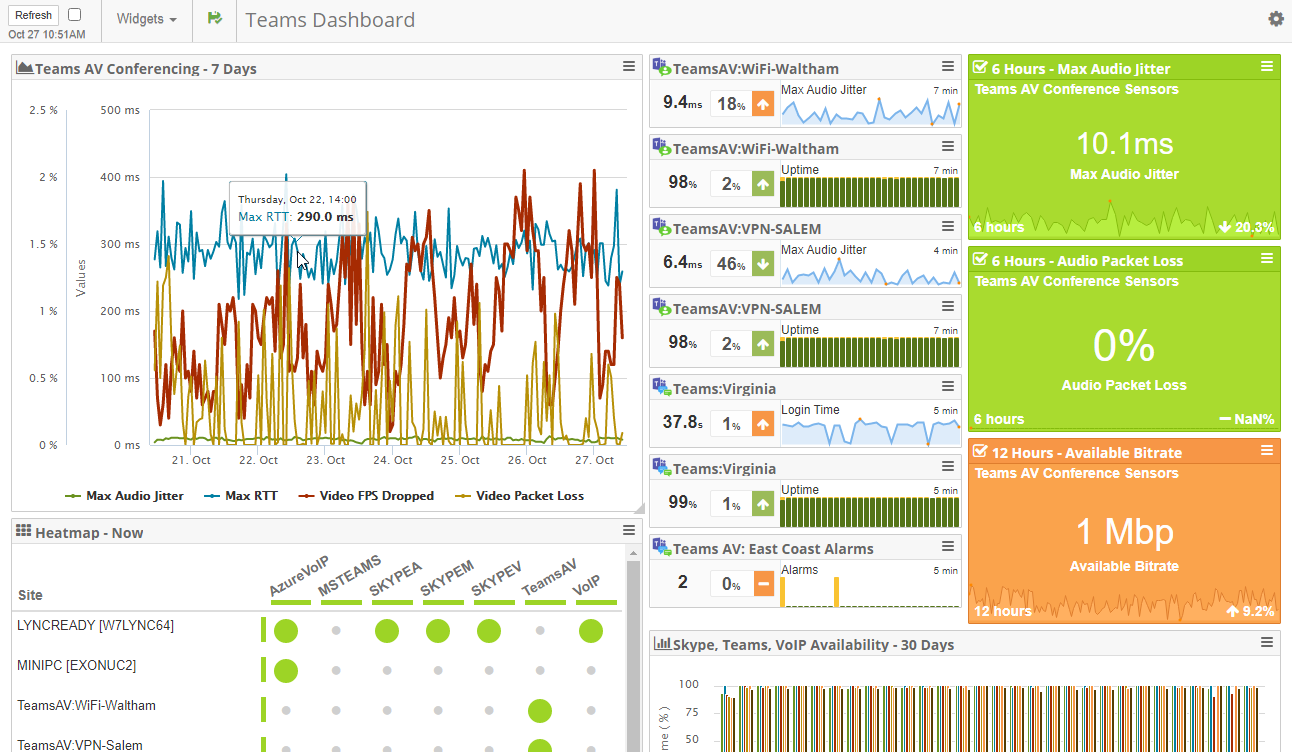 +
+We have customers that typically have a 3-5 month payback period when it comes to recovering service credits for Microsoft Teams outages. And that just isn’t available with the Teams Call Quality Analytics Dashboard.
